Modification of Luffa Sponge for Enrichment of Phosphopeptides
Abstract
1. Introduction
2. Results and Discussion
2.1. Preparation and Characterization
2.2. Adsorption of Anions by Modified Luffa Sponge
2.3. Enrichment of Phosphopeptides by QB
2.4. Enrichment of Phosphopeptides from Non-Fat Milk
3. Materials and Methods
3.1. Pretreatment of Luffa Sponge
3.2. Synthesis of Quaternized Luffa Sponge
3.3. Characterization of Quaternized Luffa Sponge Materials
3.4. Adsorption of Anions
3.5. Ion Chromatography
3.6. Peptide Sample Pretreatment
3.7. Phosphopeptide Enrichment Procedure
3.8. Mass Spectrometry Analysis
4. Conclusions
Supplementary Materials
Author Contributions
Funding
Conflicts of Interest
Abbreviations
| MALDI | Matrix-assisted laser desorption ionization |
| TOF | Time-of-flight |
| MS | Mass spectrometry |
| SAX | Strong anion exchange |
| SPE | Solid-phase extraction |
| CHPTAC | 3-Chloro-2-hydroxypropyltrimethylammonium chloride |
| ECH | Epichlorohydrin |
| IAA | Iodoacetamide |
| DTT | 1,4-dithiothreitiol |
| BSA | Bovine serum albumin |
References
- Hunter, T. Signaling–2000 and Beyond. Cell 2000, 100, 113–127. [Google Scholar] [CrossRef]
- Ruprecht, B.; Lemeer, S. Proteomic analysis of phosphorylation in cancer. Expert. Rev. Proteom. 2014, 11, 259–267. [Google Scholar] [CrossRef] [PubMed]
- Huang, J.F.; Wang, F.J.; Ye, M.L.; Zou, H.F. Enrichment and separation techniques for large-scale proteomics analysis of the protein post-translational modifications. J. Chromatogr. A 2014, 1372, 1–17. [Google Scholar] [CrossRef] [PubMed]
- Ficarro, S.; Mccleland, M.L.; Stukenberg, P.T.; Burke, D.J.; Ross, M.M.; Shabanowitz, J.; Hunt, D.F.; White, F.M. Phosphoproteome analysis by mass spectrometry and its application to saccharomyces cerevisiae. Nat. Biotechnol. 2002, 20, 301–305. [Google Scholar] [CrossRef]
- Ubersax, J.A.; Ferrell, J.E. Mechanisms of specificity in protein phosphorylation. Nat. Rev. Mol. Cell Biol. 2007, 8, 530–541. [Google Scholar] [CrossRef]
- Joerg, R.; Albert, S. State-of-the-art in phosphoproteomics. Proteomics 2005, 5, 4052–4061. [Google Scholar]
- Ren, L.L.; Li, C.Y.; Shao, W.L.; Lin, W.R.; He, F.C.; Jiang, Y. TiO2 with tandem fractionation (TAFT): An approach for rapid, deep, reproducible and high-throughput phosphoproteome analysis. J. Proteome Res. 2018, 17, 710–721. [Google Scholar] [CrossRef]
- Mclachlin, D.T.; Chait, B.T. Improved beta-elimination-based affinity purification strategy for enrichment of phosphopeptides. Anal. Chem. 2003, 75, 6826–6836. [Google Scholar] [CrossRef]
- Rush., J.; Moritz, A.; Lee, K.A.; Guo, A.; Goss, V.L.; Spek, E.J.; Zhang, H.; Zha, X.M.; Polakiewicz, R.D.; Comb, M.J. Immunoaffinity profiling of tyrosine phosphorylation in cancer cells. Nat. Biotechnol. 2004, 23, 94–101. [Google Scholar] [CrossRef]
- Stensballe, A.; Andersen, S.; Jensen, O.N. Characterization of phosphoproteins from electrophoretic gels by nanoscale Fe(III) affinity chromatography with off-line mass spectrometry analysis. Proteomics 2001, 1, 207–222. [Google Scholar] [CrossRef]
- Zhou, H.J.; Ye, M.L.; Dong, J.; Han, G.H.; Jiang, X.N.; Wu, R.N.; Zou, H.F. Specific phosphopeptide enrichment with immobilized titanium ion affinity chromatography adsorbent for phosphoproteome analysis. J. Proteome Res. 2008, 7, 3957–3967. [Google Scholar] [CrossRef] [PubMed]
- Larsen, M.R.; Thingholm, T.E.; Jensen, O.N.; Roepstorff, P.; Jorgensen, T.J.D. Highly selective enrichment of phosphorylated peptides from peptide mixtures using titanium dioxide microcolumns. Mol. Cell. Proteom. 2005, 4, 873–886. [Google Scholar] [CrossRef] [PubMed]
- Kweon, H.K.; Hakansson, K. Selective zirconium dioxide-based enrichment of phosphorylated peptides for mass spectrometric analysis. Anal. Chem. 2006, 78, 1743–1749. [Google Scholar] [CrossRef] [PubMed]
- Hennrich, M.L.; van den Toorn, H.W.P.; Groenewold, V.; Heck, A.J.; Mohammed, S. Ultra acidic strong cation exchange enabling the efficient enrichment of basic phosphopeptides. Anal. Chem. 2012, 84, 1804–1808. [Google Scholar] [CrossRef] [PubMed]
- Motoyama, A.; Xu, T.; Ruse, C.I.; Wohlschlegel, J.A.; Yates, J.R. Anion and cation mixed-bed ion exchange for enhanced multidimensional separations of peptides and phosphopeptides. Anal. Chem. 2007, 79, 3623–3634. [Google Scholar] [CrossRef] [PubMed][Green Version]
- Mcnulty, D.E.; Annan, R.S. Hydrophilic interaction chromatography reduces the complexity of the phosphoproteome and improves global phosphopeptide isolation and detection. Mol. Cell. Proteom. 2008, 7, 971–980. [Google Scholar] [CrossRef] [PubMed]
- Dehghani, A.; Gödderz, M.; Winter, D. Tip-based fractionation of batch-enriched phosphopeptides facilitates easy and robust phosphoproteome analysis. J. Proteome Res. 2018, 17, 46–54. [Google Scholar] [CrossRef]
- Li, X.S.; Yuan, B.F.; Feng, Y.Q. Recent advances in phosphopeptide enrichment: Strategies and techniques. Trac-Trends Anal. Chem. 2016, 78, 70–83. [Google Scholar] [CrossRef]
- Han, G.H.; Ye, M.L.; Zhou, H.J.; Jiang, X.N.; Feng, S.; Jiang, X.G.; Tian, R.J.; Wan, D.F.; Zou, H.F.; Gu, J.R. Large-scale phosphoproteome analysis of human liver tissue by enrichment and fractionation of phosphopeptides with strong anion exchange chromatography. Proteomics 2008, 8, 1346–1361. [Google Scholar] [CrossRef]
- Wang, Z.G.; Lv, N.; Bi, W.Z.; Zhang, J.L.; Ni, J.Z. Development of the affinity materials for phosphorylated proteins/peptides enrichment in phosphoproteomics analysis. Acs Appl. Mater. Interfaces 2015, 7, 8377–8392. [Google Scholar] [CrossRef]
- Hargrove, A.E.; Nieto, S.; Zhang, T.; Sessler, J.L.; Anslyn, E.V. Artificial receptors for the recognition of phosphorylated molecules. Chem. Rev. 2011, 111, 6603–6782. [Google Scholar] [CrossRef] [PubMed]
- Zhang, Y.; Wang, H.J.; Lu, H.J. Sequential selective enrichment of phosphopeptides and glycopeptides using amine-functionalized magnetic nanoparticles. Mol. Biosyst. 2013, 9, 492–500. [Google Scholar] [CrossRef] [PubMed]
- Xiong, Z.C.; Chen, Y.J.; Zhang, L.Y.; Ren, J.; Zhang, Q.Q.; Ye, M.L.; Zhang, W.B.; Zou, H.F. Facile synthesis of guanidyl-functionalized magnetic polymer microspheres for tunable and specific capture of global phosphopeptides or only multiphosphopeptides. Acs Appl. Mater. Interfaces 2014, 6, 22743–22750. [Google Scholar] [CrossRef] [PubMed]
- Chen, C.T.; Wang, L.Y.; Ho, Y.P. Use of polyethylenimine-modified magnetic nanoparticles for highly specific enrichment of phosphopeptides for mass spectrometric analysis. Anal. Bioanal. Chem. 2011, 399, 2795–2806. [Google Scholar] [CrossRef] [PubMed]
- Chang, C.K.; Wu, C.C.; Wang, Y.S.; Chang, H.C. Selective extraction and enrichment of multiphosphorylated peptides using polyarginine-coated diamond nanoparticles. Anal. Chem. 2008, 80, 3791–3797. [Google Scholar] [CrossRef]
- Dai, L.L.; Jin, S.X.; Fan, M.Y.; Zhou, P. Preparation of quaternized cellulose/chitosan microspheres for selective enrichment of phosphopeptides. Anal. Bioanal. Chem. 2017, 409, 3309–3317. [Google Scholar] [CrossRef]
- Dong, M.M.; Wu, M.H.; Wang, F.J.; Qin, H.Q.; Han, G.H.; Dong, J.; Wu, R.A.; Ye, M.L.; Liu, Z.; Zou, H.F. Coupling strong anion-exchange monolithic capillary with MALDI-TOF MS for sensitive detection of phosphopeptides in protein digest. Anal. Chem. 2010, 8, 2907–2915. [Google Scholar] [CrossRef]
- Saeed, A.; Iqbal, M. Loofa (Luffa cylindrica) sponge: Review of development of the biomatrix as a tool for biotechnological applications. Biotechnol. Prog. 2013, 29, 573–600. [Google Scholar] [CrossRef]
- Rowell, R.M.; Han, J.S.; Rowell, J.S. Characterization and factors effecting fiber properties. In Natural Polymers and Agrofibers Based Composites; Frollini, E., Leao, A.L., Mattoso, L.H.C., Eds.; Embrapa Agricultural Instrumentation: San Carlos, Brazil, 2000; pp. 115–134. [Google Scholar]
- Chen, Q.; Shi, Q.; Gorb, S.N.; Li, Z.Y. A multiscale study on the structural and mechanical properties of the luffa sponge from Luffa cylindrica plant. J. Biomech. 2014, 47, 1332–1339. [Google Scholar] [CrossRef]
- Roy, D.; Semsarilar, M.; Guthrie, J.T.; Perrier, S. Cheminform abstract: Cellulose modification by polymer grafting: A review. Chem. Soc. Rev. 2009, 38, 2046–2064. [Google Scholar] [CrossRef]
- Figueiredo, P.C.; Lintinen, K.; Hirvonen, J.T.; Kostiainen, M.A.; Santos, H.I.A. Properties and chemical modifications of lignin: Towards lignin-based nanomaterials for biomedical applications. Prog. Mater. Sci. 2018, 93, 233–269. [Google Scholar] [CrossRef]
- Akhtar, N.; Iqbal, J.; Iqbal, M. Microalgal-luffa sponge immobilized disc: A new efficient biosorbent for the removal of Ni(II) from aqueous solution. Lett. Appl. Microbiol. 2013, 37, 149–153. [Google Scholar] [CrossRef] [PubMed]
- Gupta, V.K.; Pathania, D.; Agarwal, S.; Sharma, S. Amputation of congo red dye from waste water using microwave induced grafted Luffa cylindrica cellulosic fiber. Carbohydr. Polym. 2014, 111, 556–566. [Google Scholar] [CrossRef] [PubMed]
- Ye, C.L.; Hu, N.; Wang, Z.K. Experimental investigation of Luffa cylindrica as a natural sorbent material for the removal of a cationic surfactant. J. Taiwan Inst. Chem. Eng. 2013, 44, 74–80. [Google Scholar] [CrossRef]
- Iqbal, M.; Zafar, S.I. The use of fibrous network of matured dried fruit of Luffa aegyptica as immobilizing agent. Biotechnol. Tech. 1993, 7, 15–18. [Google Scholar] [CrossRef]
- Iqbal, M.; Zafar, S.I. Vegetable sponge as a matrix to immobilize micro-organisms: A trial study for hyphal fungi, yeast and bacteria. Lett. Appl. Microbiol. 1994, 18, 214–217. [Google Scholar] [CrossRef]
- Lu, Z.; Duan, J.; He, L.; Hu, Y.; Yin, Y. Mesoporous TiO2 Nanocrystal Clusters for Selective Enrichment of Phosphopeptides. Anal. Chem. 2010, 82, 7249–7258. [Google Scholar] [CrossRef]
- Li, X.; Su, X.; Zhu, G.; Zhao, Y.; Yuan, B.; Guo, L.; Feng, Y. Titanium-containing magnetic mesoporous silica spheres: Effective enrichment of peptides and simultaneous separation of nonphosphopeptides and phosphopeptides. J. Sep. Sci. 2012, 35, 1506–1513. [Google Scholar] [CrossRef]
- Li, K.; Zhao, S.; Yan, Y.; Zhang, D.; Peng, M.; Wang, Y.; Guo, G.; Wang, X. In-tube solid-phase microextraction capillary column packed with mesoporous TiO2 nanoparticles for phosphopeptide analysis. Electrophor. 2019, 40, 2142–2148. [Google Scholar] [CrossRef]
- Gao, C.; Bai, J.; He, Y.; Zheng, Q.; Ma, W.; Lei, Z.; Zhang, M.; Wu, J.; Fu, F.; Lin, Z. Covalent organic frameworks for selective enrichment of phosphopeptides. Acs Appl. Mater. Interfaces 2019, 11, 13735–13741. [Google Scholar] [CrossRef]
- Jiang, J.; Sun, X.; She, X.; Li, J.; Li, Y.; Deng, C.; Duan, G. Magnetic microspheres modified with Ti(IV) and Nb(V) for enrichment of phosphopeptides. Microchim. Acta 2018, 185, 309–316. [Google Scholar] [CrossRef] [PubMed]
- Hussain, D.; Musharraf, S.G.; Fatima, B.; Saeed, A.; Jabeen, F.; Ashiq, M.N.; Najam-ul-Haq, M. Magnetite nanoparticles coated with chitosan and polyethylenimine as anion exchanger for sorptive enrichment of phosphopeptides. Microchim. Acta 2019, 186, 852–861. [Google Scholar]
- Luo, B.; Yang, M.; Jiang, P.; Lan, F.; Wu, Y. Multi-affinity sites of magnetic guanidyl-functionalized metal–organic framework nanospheres for efficient enrichment of global phosphopeptides. Nanoscale 2018, 10, 8391–8396. [Google Scholar] [CrossRef] [PubMed]
- Wang, J.; Wang, Z.; Sun, N.; Deng, C. Immobilization of titanium dioxide/ions on magnetic microspheres for enhanced recognition and extraction of mono- and multi-phosphopeptides. Microchim. Acta 2019, 186, 236–244. [Google Scholar]
- Zhang, M.; Zhang, T.; Song, S.; Wang, J.; Chen, Z.; Xia, S. Preparation and adsorption properties of a quaternary ammonium net anion-exchange fiber. Chin. J. Env. Eng. 2015, 9, 2144–2148. [Google Scholar]
- Bahl, J.M.C.; Jensen, S.S.; Larsen, M.R.; Heegaard, N.H.H. Characterization of the human cerebrospinal fluid phosphoproteome by titanium dioxide affinity chromatography and mass Spectrometry. Anal. Chem. 2008, 80, 6308–6316. [Google Scholar] [CrossRef]
- Jin, S.; Liu, L.; Zhou, P. Amorphous titania modified with boric acid for selective capture of glycoproteins. Microchim. Acta 2018, 185, 308–314. [Google Scholar] [CrossRef]
- Kjellstrom, S.; Jensen, O.N. Phosphoric acid as a matrix additive for MALDI MS analysis of phosphopeptides and phosphoproteins. Anal. Chem. 2004, 76, 5109–5117. [Google Scholar] [CrossRef]
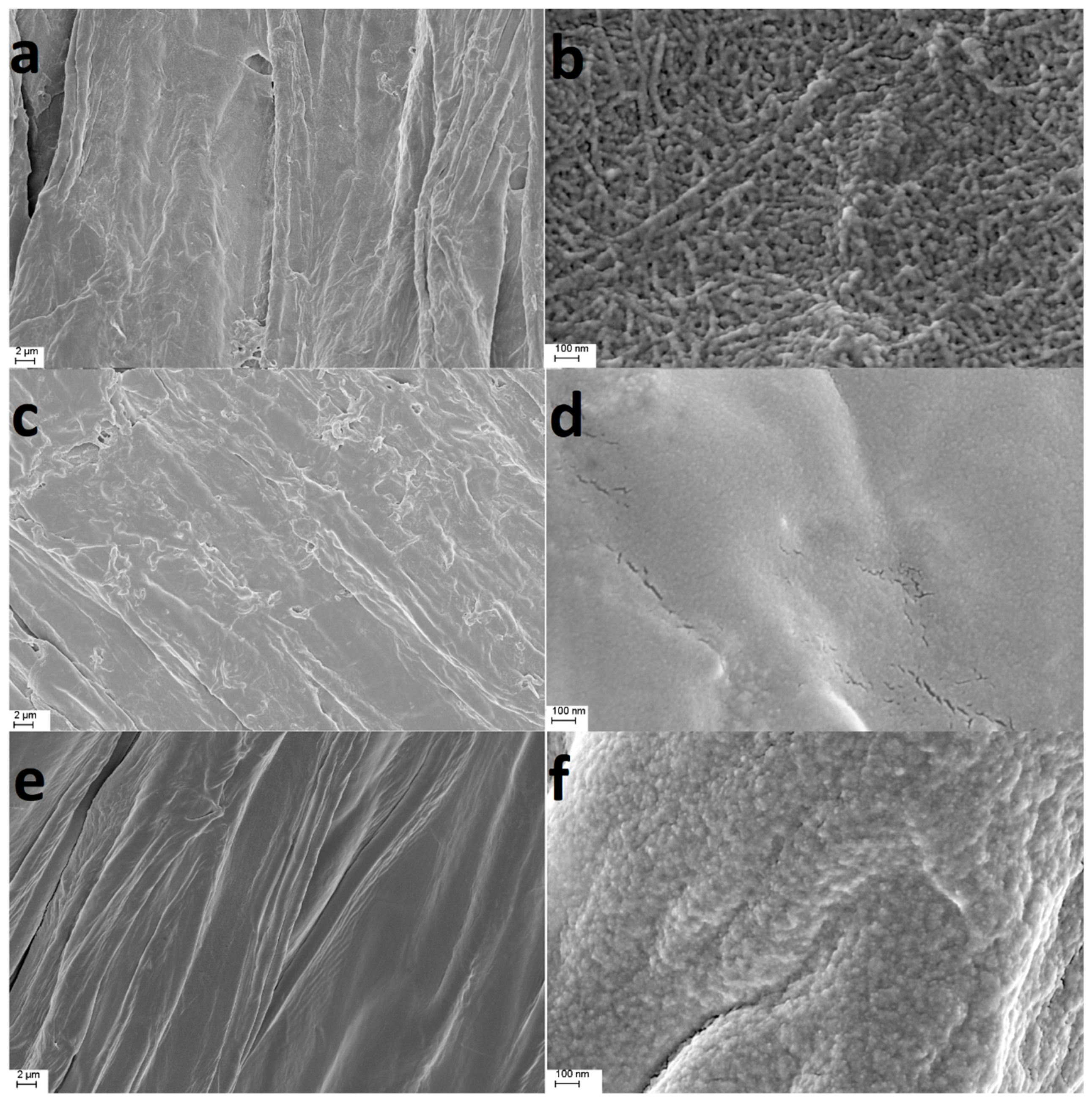
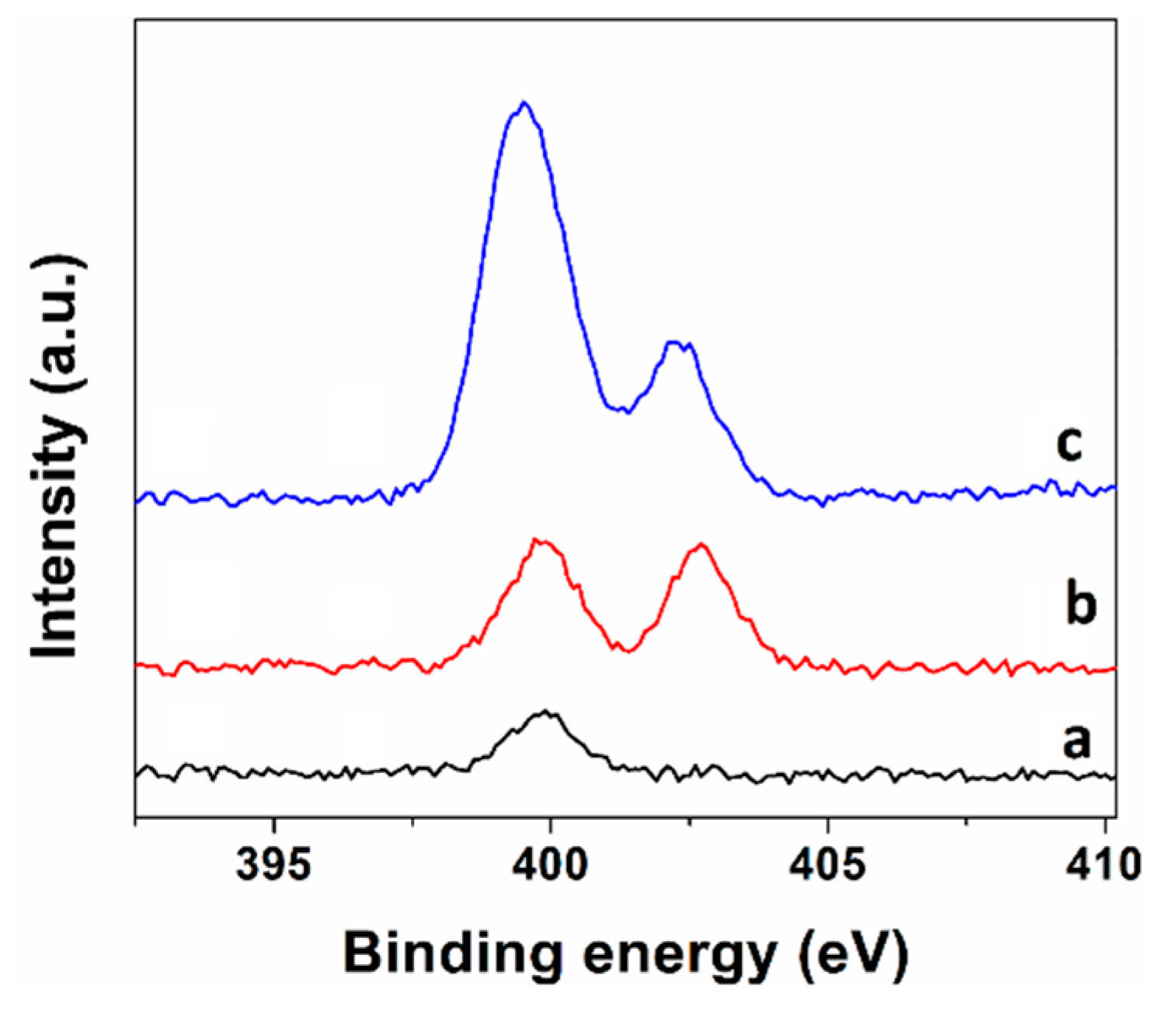
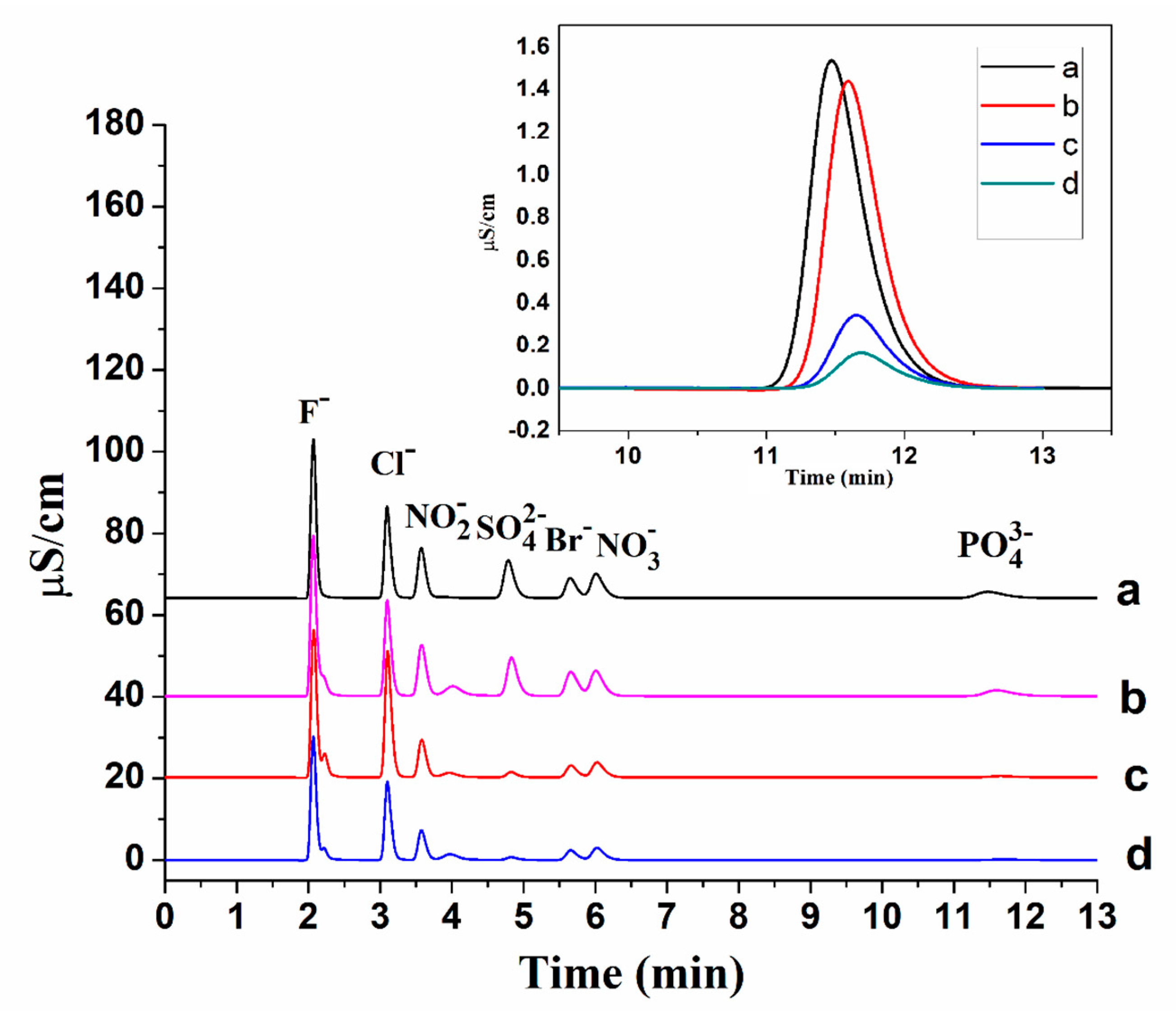
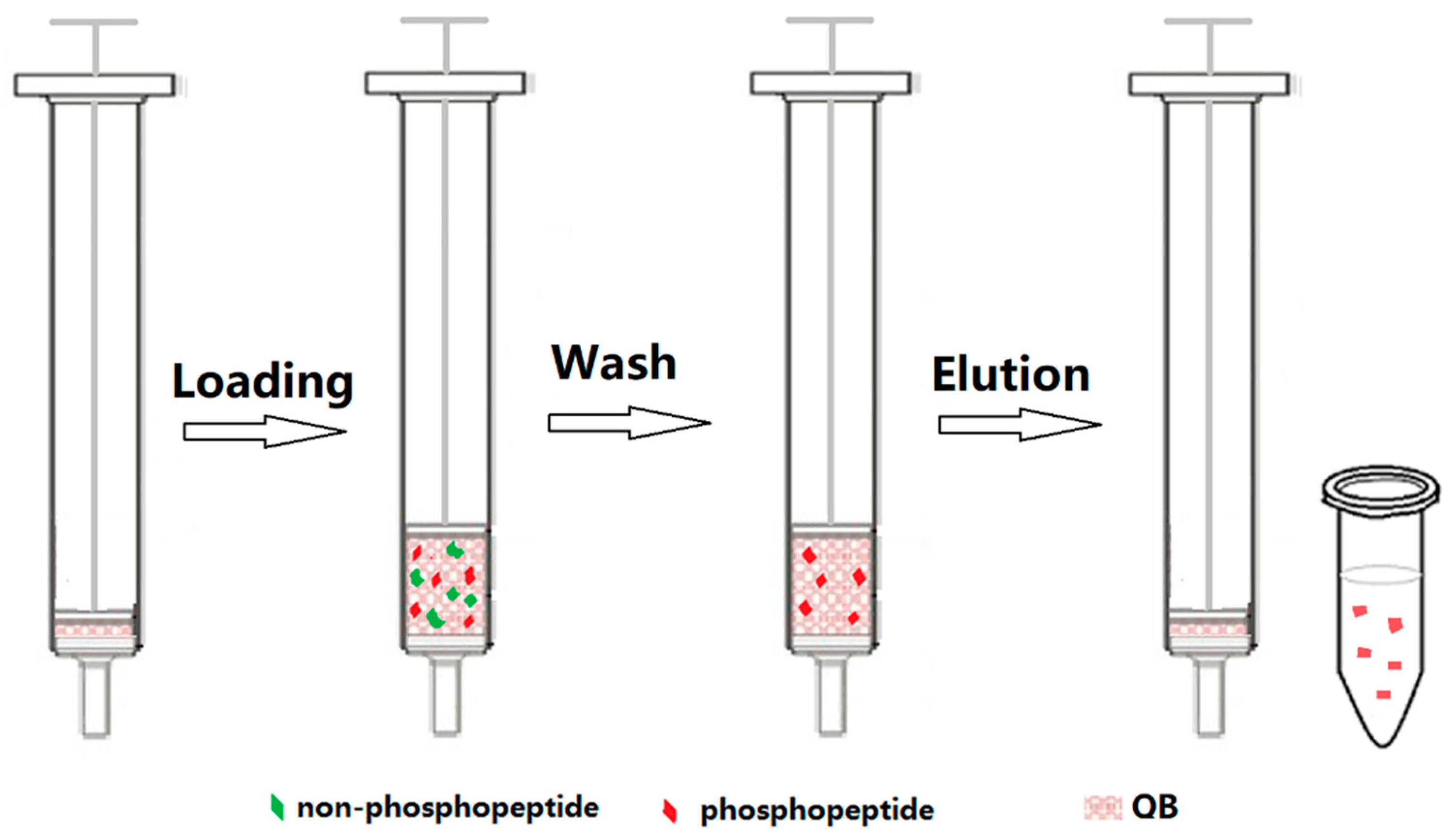
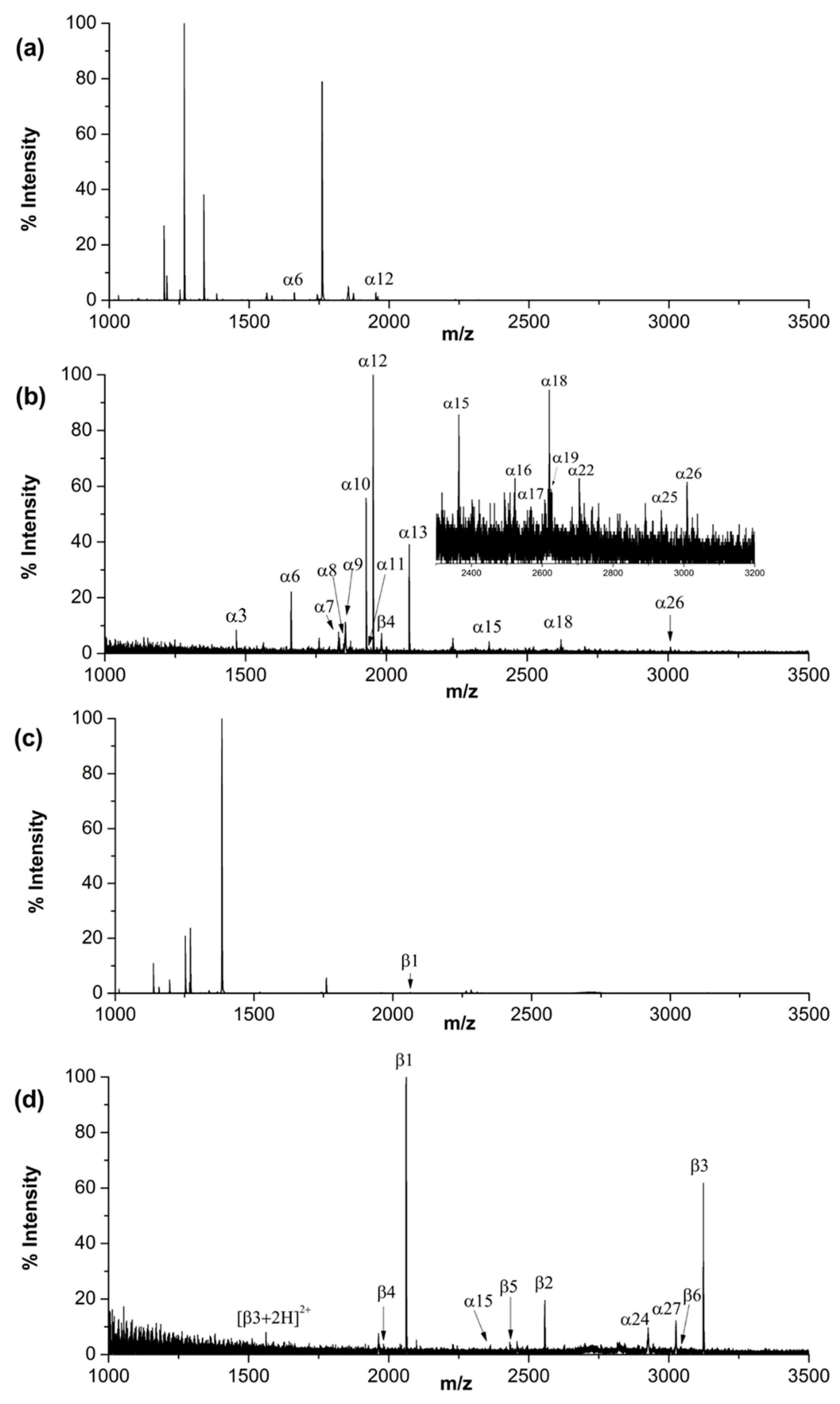
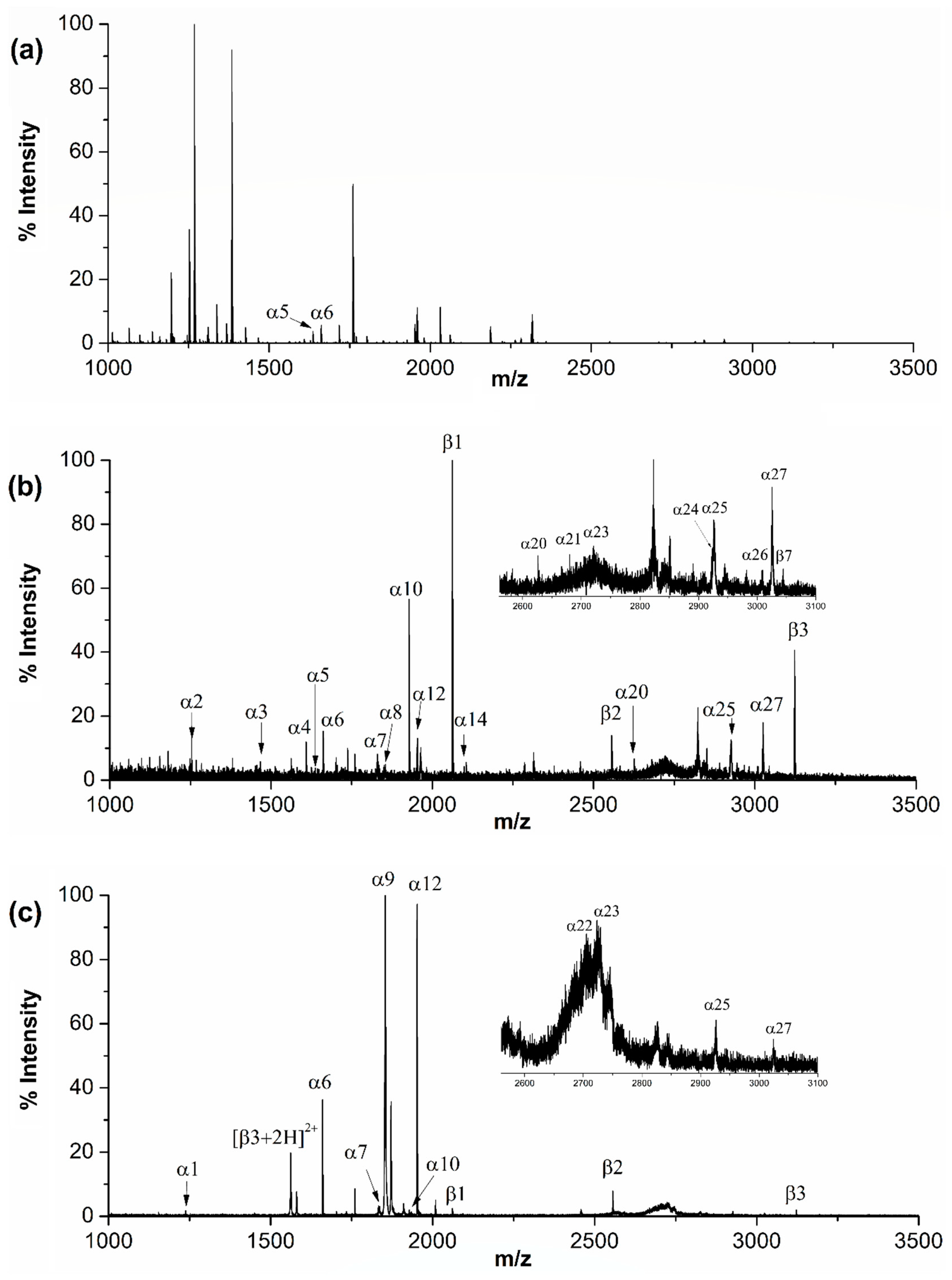
© 2019 by the authors. Licensee MDPI, Basel, Switzerland. This article is an open access article distributed under the terms and conditions of the Creative Commons Attribution (CC BY) license (http://creativecommons.org/licenses/by/4.0/).
Share and Cite
Dai, L.; Sun, Z.; Zhou, P. Modification of Luffa Sponge for Enrichment of Phosphopeptides. Int. J. Mol. Sci. 2020, 21, 101. https://doi.org/10.3390/ijms21010101
Dai L, Sun Z, Zhou P. Modification of Luffa Sponge for Enrichment of Phosphopeptides. International Journal of Molecular Sciences. 2020; 21(1):101. https://doi.org/10.3390/ijms21010101
Chicago/Turabian StyleDai, Lili, Zhe Sun, and Ping Zhou. 2020. "Modification of Luffa Sponge for Enrichment of Phosphopeptides" International Journal of Molecular Sciences 21, no. 1: 101. https://doi.org/10.3390/ijms21010101
APA StyleDai, L., Sun, Z., & Zhou, P. (2020). Modification of Luffa Sponge for Enrichment of Phosphopeptides. International Journal of Molecular Sciences, 21(1), 101. https://doi.org/10.3390/ijms21010101



